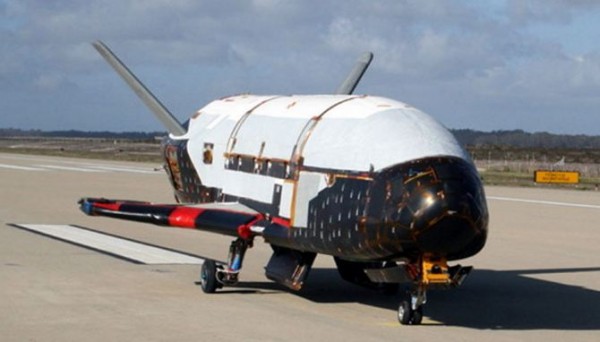U.S. Air Force’s Top Secret X-37B Spaceplane Breaks Space Endurance Record
| Arthur Dominic Villasanta | | Mar 27, 2017 09:55 PM EDT |
(Photo : USAF) X-37B of the USAF.
The U.S. Air Force's secret X-37B spaceplane on March 25 broke the world space endurance record by a spaceplane.
The X-37B, whose current mission is identified as OTV-4, exceeded the current record of 674 days in orbit to reach 675 days on March 25. The former record for the longest time spent orbiting the Earth by a spaceplane capable of a return flight was set by the OTV-3 mission.
Like Us on Facebook
OTV-4 blasted-off from Cape Canaveral Air Force Station in Florida on May 20, 2015 aboard a United Launch Alliance Atlas V rocket. As with the previous three OTV missions, the Air Force remained tight-lipped about the true purpose of the OTV-4 mission. Speculation abounds, however.
The previous X-37B record of 674 days in space was set by OTV-3, which launched from Cape Canaveral Air Force Station on December 12, 2012 and landed at Vandenberg Air Force Base on October 17, 2014. The X-37B was originally designed for orbital missions lasting 270 days.
The U.S. Air Force left open the possibility of landing the X-37B on the space shuttle landing strip at Kennedy Space Center in Florida.
There are persistent reports the Air Force is testing a working version of the controversial EmDrive electromagnetic thruster aboard the OTV-4 mission.
If true, the report of an EmDrive aboard the X-37B might help explain why the spaceplane remains in orbit well past its announced mission life of 200 days.
Also called a radio frequency (RF) resonant cavity thruster, an EmDrive or Em Drive uses no reaction mass and emits no directional radiation to generate thrust. British aerospace engineer Roger Shawyer designed the EmDrive in 2001 and has promoted the idea through his company, Satellite Propulsion Research.
While the Air Force hasn't confirmed speculation an EmDrive is being tested aboard the spaceplane, what is certain is the X-37B is testing a prototype "Hall Effect Thruster" (HET) in support of the Air Force's Advanced Extremely High Frequency (AEHF) communications satellite program.
The U.S. Department of Defense said operational Hall Effect Thrusters or Hall Thrusters will propel military satellites (milsats) in Earth orbit or power future spacecraft on interplanetary voyages.
TagsU.S. Air Force, X-37B spaceplane, OTV-4, 675 days, OTV-3
©2015 Chinatopix All rights reserved. Do not reproduce without permission
EDITOR'S PICKS
-

Did the Trump administration just announce plans for a trade war with ‘hostile’ China and Russia?
-

US Senate passes Taiwan travel bill slammed by China
-

As Yan Sihong’s family grieves, here are other Chinese students who went missing abroad. Some have never been found
-

Beijing blasts Western critics who ‘smear China’ with the term sharp power
-

China Envoy Seeks to Defuse Tensions With U.S. as a Trade War Brews
-

Singapore's Deputy PM Provides Bitcoin Vote of Confidence Amid China's Blanket Bans
-

China warns investors over risks in overseas virtual currency trading
-

Chinese government most trustworthy: survey
-

Kashima Antlers On Course For Back-To-Back Titles
MOST POPULAR
LATEST NEWS
Zhou Yongkang: China's Former Security Chief Sentenced to Life in Prison

China's former Chief of the Ministry of Public Security, Zhou Yongkang, has been given a life sentence after he was found guilty of abusing his office, bribery and deliberately ... Full Article
TRENDING STORY

China Pork Prices Expected to Stabilize As The Supplies Recover

Elephone P9000 Smartphone is now on Sale on Amazon India

There's a Big Chance Cliffhangers Won't Still Be Resolved When Grey's Anatomy Season 13 Returns

Supreme Court Ruled on Samsung vs Apple Dispute for Patent Infringement

Microsoft Surface Pro 5 Rumors and Release Date: What is the Latest?











